科普著作的文体与翻译
- 格式:pdf
- 大小:432.53 KB
- 文档页数:4
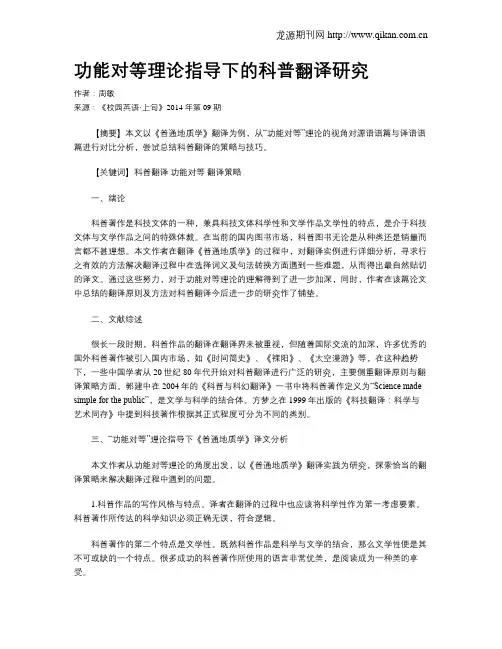
功能对等理论指导下的科普翻译研究作者:周敏来源:《校园英语·上旬》2014年第09期【摘要】本文以《普通地质学》翻译为例,从“功能对等”理论的视角对源语语篇与译语语篇进行对比分析,尝试总结科普翻译的策略与技巧。
【关键词】科普翻译功能对等翻译策略一、绪论科普著作是科技文体的一种,兼具科技文体科学性和文学作品文学性的特点,是介于科技文体与文学作品之间的特殊体裁。
在当前的国内图书市场,科普图书无论是从种类还是销量而言都不甚理想。
本文作者在翻译《普通地质学》的过程中,对翻译实例进行详细分析,寻求行之有效的方法解决翻译过程中在选择词义及句法转换方面遇到一些难题,从而得出最自然贴切的译文。
通过这些努力,对于功能对等理论的理解得到了进一步加深,同时,作者在该篇论文中总结的翻译原则及方法对科普翻译今后进一步的研究作了铺垫。
二、文献综述很长一段时期,科普作品的翻译在翻译界未被重视,但随着国际交流的加深,许多优秀的国外科普著作被引入国内市场,如《时间简史》、《裸阳》、《太空漫游》等,在这种趋势下,一些中国学者从20世纪80年代开始对科普翻译进行广泛的研究,主要侧重翻译原则与翻译策略方面。
郭建中在2004年的《科普与科幻翻译》一书中将科普著作定义为“Science made simple for the public”,是文学与科学的结合体。
方梦之在1999年出版的《科技翻译:科学与艺术同存》中提到科技著作根据其正式程度可分为不同的类别。
三、“功能对等”理论指导下《普通地质学》译文分析本文作者从功能对等理论的角度出发,以《普通地质学》翻译实践为研究,探索恰当的翻译策略来解决翻译过程中遇到的问题。
1.科普作品的写作风格与特点。
译者在翻译的过程中也应该将科学性作为第一考虑要素。
科普著作所传达的科学知识必须正确无误,符合逻辑。
科普著作的第二个特点是文学性。
既然科普作品是科学与文学的结合,那么文学性便是其不可或缺的一个特点。
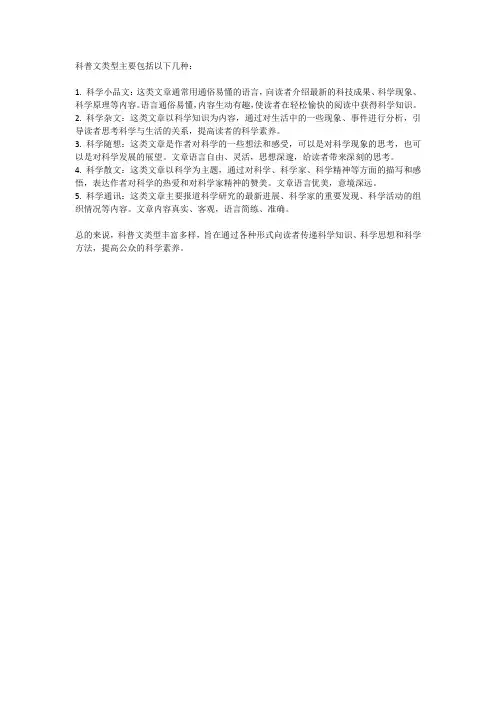
科普文类型主要包括以下几种:
1. 科学小品文:这类文章通常用通俗易懂的语言,向读者介绍最新的科技成果、科学现象、科学原理等内容。
语言通俗易懂,内容生动有趣,使读者在轻松愉快的阅读中获得科学知识。
2. 科学杂文:这类文章以科学知识为内容,通过对生活中的一些现象、事件进行分析,引导读者思考科学与生活的关系,提高读者的科学素养。
3. 科学随想:这类文章是作者对科学的一些想法和感受,可以是对科学现象的思考,也可以是对科学发展的展望。
文章语言自由、灵活,思想深邃,给读者带来深刻的思考。
4. 科学散文:这类文章以科学为主题,通过对科学、科学家、科学精神等方面的描写和感悟,表达作者对科学的热爱和对科学家精神的赞美。
文章语言优美,意境深远。
5. 科学通讯:这类文章主要报道科学研究的最新进展、科学家的重要发现、科学活动的组织情况等内容。
文章内容真实、客观,语言简练、准确。
总的来说,科普文类型丰富多样,旨在通过各种形式向读者传递科学知识、科学思想和科学方法,提高公众的科学素养。
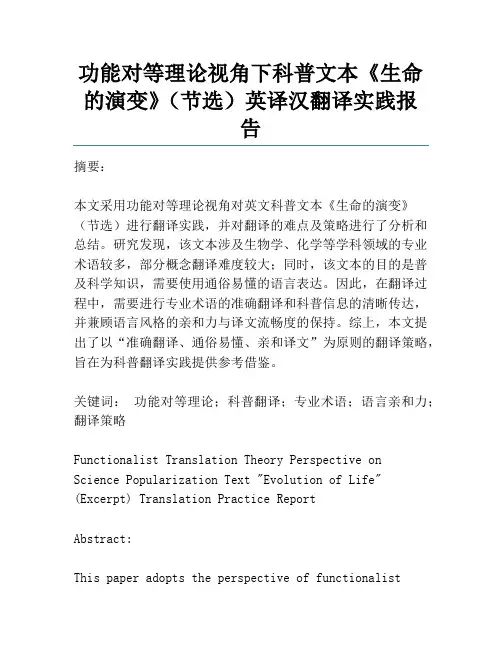
功能对等理论视角下科普文本《生命的演变》(节选)英译汉翻译实践报告摘要:本文采用功能对等理论视角对英文科普文本《生命的演变》(节选)进行翻译实践,并对翻译的难点及策略进行了分析和总结。
研究发现,该文本涉及生物学、化学等学科领域的专业术语较多,部分概念翻译难度较大;同时,该文本的目的是普及科学知识,需要使用通俗易懂的语言表达。
因此,在翻译过程中,需要进行专业术语的准确翻译和科普信息的清晰传达,并兼顾语言风格的亲和力与译文流畅度的保持。
综上,本文提出了以“准确翻译、通俗易懂、亲和译文”为原则的翻译策略,旨在为科普翻译实践提供参考借鉴。
关键词:功能对等理论;科普翻译;专业术语;语言亲和力;翻译策略Functionalist Translation Theory Perspective on Science Popularization Text "Evolution of Life" (Excerpt) Translation Practice ReportAbstract:This paper adopts the perspective of functionalisttranslation theory to carry out translation practice for the English science popularization text "Evolution of Life" (excerpt), and analyzes and summarizes the difficulties and strategies of translation. The study found that this text contains many professional terms in the fields of biology, chemistry, etc., and some concepts are difficult to translate; at the same time, the purpose of this text is to popularize scientific knowledge and requires the use of easy-to-understand language. Therefore, in the process of translation, it is necessary to accurately translate professional terms and clearly convey scientific popularization information while taking into account the language style affinity and translation fluency. Therefore,this paper proposes a translation strategy based on the principles of "accurate translation, easy-to-understand, and language affinity", and is intended to provide reference for science popularization translation practice.Keywords: functionalist translation theory; science popularization translation; professional terminology; language affinity; translation strategyI. IntroductionIn recent years, with the progress of science andtechnology, the importance of science dissemination has become increasingly prominent. Science popularization translation, as an important part of science dissemination, plays a vital role in promoting the communication and exchange of scientific research achievements, improving people's scientific literacy, and promoting the development of science and technology.However, science popularization translation is not an easy task. It is not only necessary to accurately translate professional terminology, but also to ensure that the translation is easily understood by the general public. Moreover, it is important to take into account the language style affinity and translation fluency. Therefore, this paper proposes a translation strategy based on the principles of "accurate translation, easy-to-understand, and language affinity", and is intended to provide reference for science popularization translation practice.II. Principles of Functionalism Translation TheoryFunctionalism translation theory is one of the important translation theories. It emphasizes the communicative function of language, and regards the translation as a communicative act between twodifferent linguistic and cultural systems. The goal of functionalism translation theory is to achieve communicative success, that is, to ensure that the translated text can effectively convey the purpose and meaning of the source text to the target readers.Based on the principles of functionalism translation theory, the translation strategy proposed in thispaper includes the following aspects:1. Accurate Translation of Professional TerminologyProfessional terminology is the core content of most scientific popularization texts. The accuracy of professional terminology translation has a direct impact on the readability and credibility of the translated text. Therefore, in the translation process, it is necessary to ensure the accurate translation of professional terminology, to maintain the consistency and accuracy of the scientific content, and to avoid causing misunderstandings due to inaccurate translation.2. Easy-to-Understand TranslationScience popularization translation is aimed at the general public, so it is necessary to use simple andeasy-to-understand language to convey the scientific content. At the same time, the translator should pay attention to the cultural differences betweendifferent languages, and use the localized expressions that target readers can understand. For example, in the translation of different units of measurement, the translator can use the equivalent units of the target language to make it easier for readers to understand.3. Language AffinityLanguage affinity refers to the similarity in vocabulary, grammar, syntax and expression between the source and target languages. In the translation of science popularization texts, language affinity is of great significance for improving the readability and fluency of the translated text. Therefore, the translator should pay attention to the languageaffinity between the source and target languages, and choose appropriate translation methods according to the specific situation, such as using the target language's commonly used expressions to replace the lengthy grammar of the source language.III. ConclusionIn summary, the translation of science popularizationtexts is not only a professional translation work, but also a popularization work. The translation strategy proposed in this paper based on the principles of functionalism translation theory, can guide the translators to accurately and effectively translate the scientific content, and make the translated text easy to understand and have language affinity. In the actual translation practice, the translator should pay attention to the combination of theory and practice, work hard to improve language skills and communication skills, and continuously explore and innovate translation methods to promote the dissemination and popularization of scientific knowledgeIn addition to the importance of translation theory, the translator also needs to have a strong understanding of the scientific knowledge they are translating. They need to be familiar with the terminology and jargon used in the specific field to accurately convey the meaning of the text. This requires the translator to not only have expertise in language, but also in the scientific area they are working with.Moreover, the translator needs to consider the target audience for the translated text. The scientific content may need to be simplified for a generalreadership or specialized for professionals. The translator needs to smoothly navigate between the scientific and linguistic contexts, and ensure that the translated text is not only accurate, but also clear and easy to understand for the intended readership.Technology has also played a great role in the translation of scientific content. Machine translation tools have greatly improved and are able to provide fast and convenient translations. However, these tools still lack the ability to accurately convey scientific terminology and context-specific language. Therefore, human translators with scientific expertise are still essential for accurate and effective translation in this field.In conclusion, the translation of scientific contentis a complex and challenging task that requires both linguistic and scientific knowledge, as well as an understanding of the target audience. The translator needs to constantly improve their skills and explore new translation methods to promote the dissemination and popularization of scientific knowledge across different languages and culturesAdditionally, the translator must also be able to work closely with scientists and researchers, as well as editors and publishers, to ensure that the content is accurate and meets the standards of the scientific community. This means being able to understand and interpret technical terminology, as well as being able to convey complex scientific concepts in a clear and concise way.One of the key challenges in translating scientific content is the need to balance accuracy with readability. While it is important to ensure that the content is scientifically accurate, it is equally important to make it accessible and easy to understand for the target audience. This requires the translator to not only have excellent linguistic skills, but also to be able to understand the cultural and social context of the target audience.Another challenge in translating scientific content is the need to keep up with the latest developments and advancements in the field. This requires thetranslator to stay informed and up-to-date on the latest research, discoveries, and trends, and to be able to incorporate this knowledge into their translations. This can be particularly challenging in rapidly evolving fields, such as biotechnology ornanotechnology, where new discoveries are being made on a regular basis.Despite the challenges, the translation of scientific content plays a crucial role in promoting scientific progress and knowledge sharing across different languages and cultures. It helps to break downbarriers and create a more inclusive and interconnected scientific community, where researchers and scientists from different countries and regions can collaborate and share their knowledge and expertise.In conclusion, translating scientific content is a complex and challenging task that requires both linguistic and scientific expertise, as well as an understanding of the target audience. It is an essential part of promoting scientific progress and knowledge sharing, and plays a crucial role in breaking down barriers and creating a more connected and inclusive scientific community. As such, it is an important area of focus for translators andtranslation professionals, who play a vital role in bridging the gap between scientists and the general publicIn conclusion, scientific translation is a challenging task that requires linguistic and scientific expertise, as well as an understanding of the target audience. It is essential for promoting scientific progress and knowledge sharing and plays a vital role in creating a more connected and inclusive scientific community. Translators and translation professionals have an important role to play in bridging the gap between scientists and the general public。
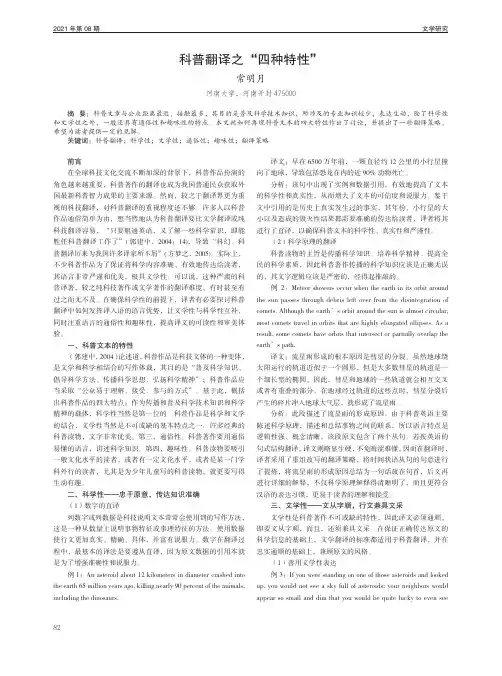
科普翻译之“四种特性”常明月前言在全球科技文化交流不断加深的背景下,科普作品扮演的角色越来越重要,科普著作的翻译也成为我国普通民众获取外国最新科普智力成果的主要来源。
然而,较之于翻译界更为重视的科技翻译,对科普翻译的重视程度还不够。
许多人以科普作品通俗简单为由,想当然地认为科普翻译要比文学翻译或纯科技翻译容易,“只要粗通英语,又了解一些科学常识,即能胜任科普翻译工作了”(郭建中,2004:14),导致“科幻、科普翻译历来为我国许多译家所不屑”(方梦之,2005)。
实际上,不少科普作品为了保证将科学内容准确、有效地传达给读者,其语言非常严谨和优美,极具文学性。
可以说,这种严肃的科普译著,较之纯科技著作或文学著作的翻译难度,有时甚至有过之而无不及。
在确保科学性的前提下,译者有必要探讨科普翻译中如何发挥译入语的语言优势,让文学性与科学性互补,同时注重语言的通俗性和趣味性,提高译文的可读性和审美体验。
一、科普文本的特性(郭建中,2004)论述道,科普作品是科技文体的一种变体,是文学和科学相结合的写作体裁,其目的是“普及科学知识、倡导科学方法、传播科学思想、弘扬科学精神”;科普作品应当采取“公众易于理解、接受、参与的方式”。
基于此,概括出科普作品的四大特点:作为传播和普及科学技术知识和科学精神的载体,科学性当然是第一位的。
科普作品是科学和文学的结合,文学性当然是不可或缺的基本特点之一。
许多经典的科普读物,文字非常优美。
第三,通俗性。
科普著作要用通俗易懂的语言,讲述科学知识。
第四,趣味性。
科普读物要吸引一般文化水平的读者,或者有一定文化水平,或者是某一门学科外行的读者,尤其是为少年儿童写的科普读物,就更要写得生动有趣。
二、科学性——忠于原意,传达知识准确(1)数字的直译列数字或列数据是科技说明文本常常会使用到的写作方法,这是一种从数量上说明事物特征或事理特征的方法。
使用数据使行文更加真实、精确、具体,并富有说服力。
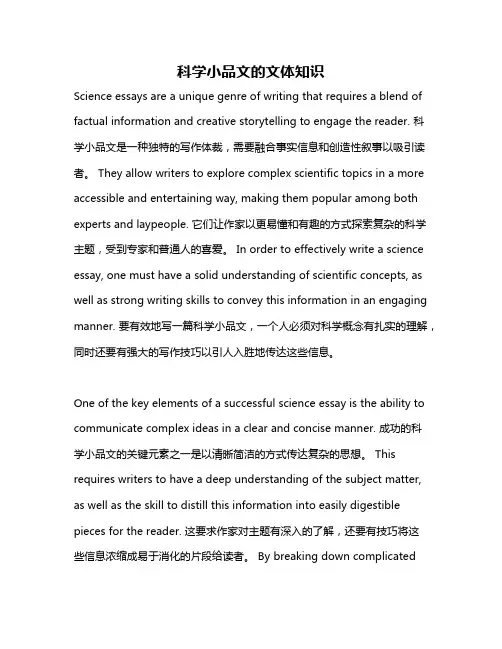
科学小品文的文体知识Science essays are a unique genre of writing that requires a blend of factual information and creative storytelling to engage the reader. 科学小品文是一种独特的写作体裁,需要融合事实信息和创造性叙事以吸引读者。
They allow writers to explore complex scientific topics in a more accessible and entertaining way, making them popular among both experts and laypeople. 它们让作家以更易懂和有趣的方式探索复杂的科学主题,受到专家和普通人的喜爱。
In order to effectively write a science essay, one must have a solid understanding of scientific concepts, as well as strong writing skills to convey this information in an engaging manner. 要有效地写一篇科学小品文,一个人必须对科学概念有扎实的理解,同时还要有强大的写作技巧以引人入胜地传达这些信息。
One of the key elements of a successful science essay is the ability to communicate complex ideas in a clear and concise manner. 成功的科学小品文的关键元素之一是以清晰简洁的方式传达复杂的思想。
This requires writers to have a deep understanding of the subject matter, as well as the skill to distill this information into easily digestible pieces for the reader. 这要求作家对主题有深入的了解,还要有技巧将这些信息浓缩成易于消化的片段给读者。
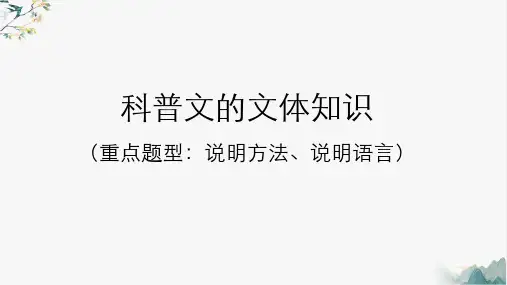
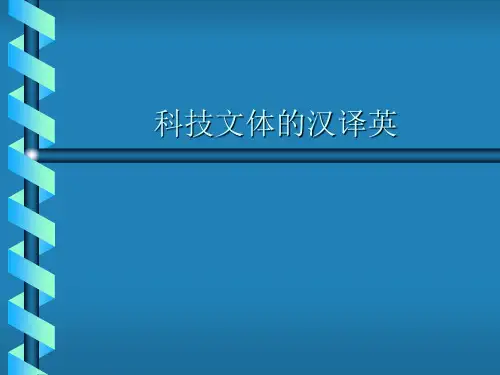
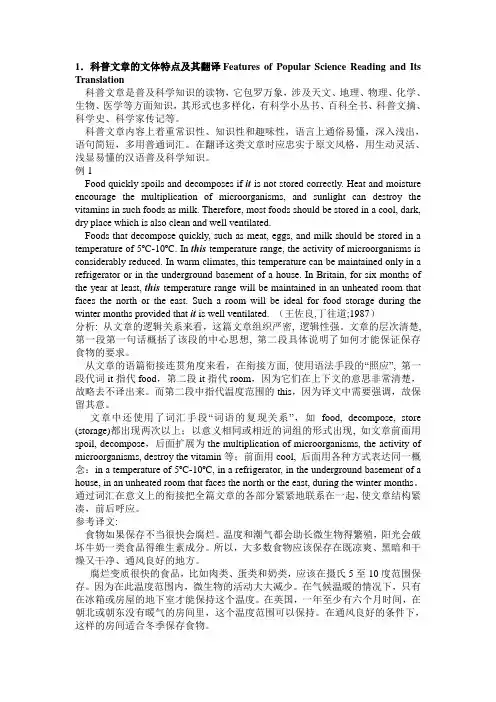
1.科普文章的文体特点及其翻译Features of Popular Science Reading and Its Translation科普文章是普及科学知识的读物,它包罗万象,涉及天文、地理、物理、化学、生物、医学等方面知识,其形式也多样化,有科学小丛书、百科全书、科普文摘、科学史、科学家传记等。
科普文章内容上着重常识性、知识性和趣味性,语言上通俗易懂,深入浅出,语句简短,多用普通词汇。
在翻译这类文章时应忠实于原文风格,用生动灵活、浅显易懂的汉语普及科学知识。
例1Food quickly spoils and decomposes if it is not stored correctly. Heat and moisture encourage the multiplication of microorganisms, and sunlight can destroy the vitamins in such foods as milk. Therefore, most foods should be stored in a cool, dark, dry place which is also clean and well ventilated.Foods that decompose quickly, such as meat, eggs, and milk should be stored in a temperature of 5ºC-10ºC. In this temperature range, the activity of microorganisms is considerably reduced. In warm climates, this temperature can be maintained only in a refrigerator or in the underground basement of a house. In Britain, for six months of the year at least, this temperature range will be maintained in an unheated room that faces the north or the east. Such a room will be ideal for food storage during the winter months provided that it is well ventilated. (王佐良,丁往道;1987)分析: 从文章的逻辑关系来看,这篇文章组织严密, 逻辑性强。
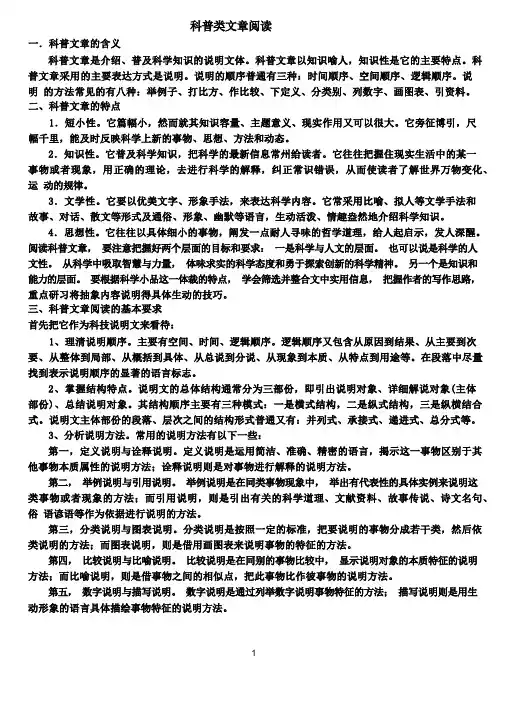
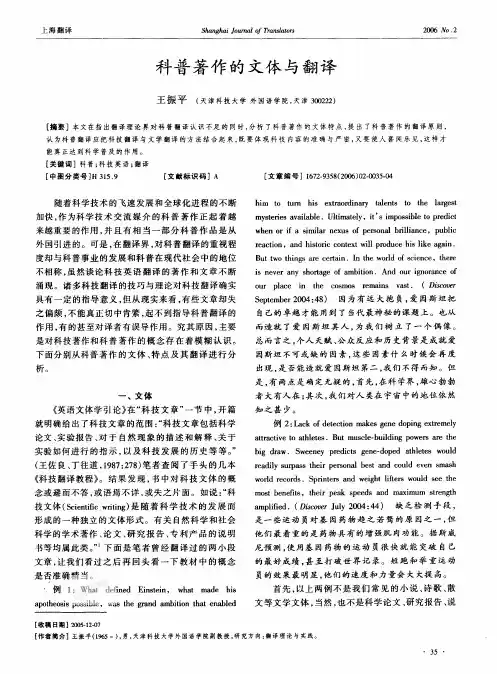
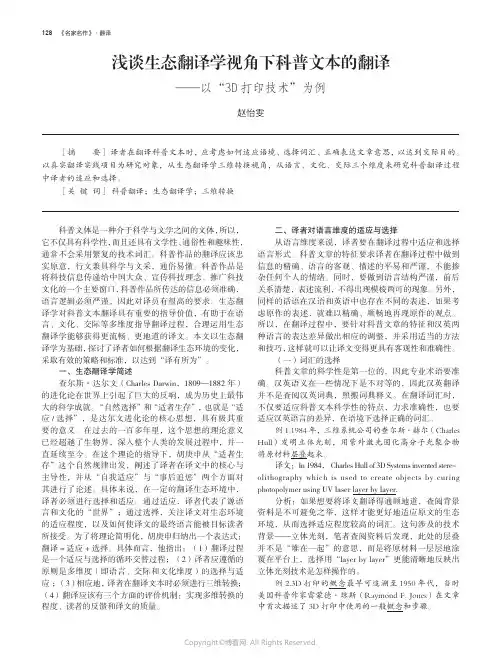
128《名家名作》·翻译[摘 要] 译者在翻译科普文本时,应考虑如何适应语境、选择词汇、正确表达文章意思,以达到交际目的。
以真实翻译实践项目为研究对象,从生态翻译学三维转换视角,从语言、文化、交际三个维度来研究科普翻译过程中译者的适应和选择。
[关 键 词] 科普翻译;生态翻译学;三维转换浅谈生态翻译学视角下科普文本的翻译——以“3D 打印技术”为例赵怡雯科普文体是一种介于科学与文学之间的文体,所以,它不仅具有科学性,而且还具有文学性、通俗性和趣味性,通常不会采用繁复的技术词汇。
科普作品的翻译应该忠实原意,行文兼具科学与文采,通俗易懂。
科普作品是将科技信息传递给中国大众、宣传科技理念、推广科技文化的一个主要窗口,科普作品所传达的信息必须准确,语言逻辑必须严谨,因此对译员有很高的要求。
生态翻译学对科普文本翻译具有重要的指导价值,有助于在语言、文化、交际等多维度指导翻译过程,合理运用生态翻译学能够获得更流畅、更地道的译文。
本文以生态翻译学为基础,探讨了译者如何根据翻译生态环境的变化,采取有效的策略和标准,以达到“译有所为”。
一、生态翻译学简述查尔斯·达尔文(Charles Darwin,1809—1882年)的进化论在世界上引起了巨大的反响,成为历史上最伟大的科学成就。
“自然选择”和“适者生存”,也就是“适应/选择”,是达尔文进化论的核心思想,具有极其重要的意义。
在过去的一百多年里,这个思想的理论意义已经超越了生物界,深入整个人类的发展过程中,并一直延续至今。
在这个理论的指导下,胡庚申从“适者生存”这个自然规律出发,阐述了译者在译文中的核心与主导性,并从“自我适应”与“事后追惩”两个方面对其进行了论述。
具体来说,在一定的翻译生态环境中,译者必须进行选择和适应。
通过适应,译者代表了源语言和文化的“世界”;通过选择,关注译文对生态环境的适应程度,以及如何使译文的最终语言能被目标读者所接受。
- 236-校园英语 / 翻译探究科技英语的文体特征及翻译策略——以石油英语翻译为例中国石油大学文学院/杨晓【摘要】随着现代科学技术的发展,科技英语已成为一种重要的英语文体,而阅读和翻译科技英文文献也成为科研上作者一项基本素质。
石油科技英语具有“客观性”、“规范性”、“科学性”和“现实性”等一般科技语篇特征。
本文以笔者的翻译实践为例,辅以其它译例,拟就石油科技英语的文体特征,从词汇、词法、句法、修辞四个方面对比科技文体的英汉翻译并对科技英语的翻译策略进行探析。
【关键词】科技英语 文体特征 翻译策略科技文体是自然科学和技术人员从事专业活动时使用的一种文体。
科学著作、学术论文、实验报告、产品说明书都属于科技文体。
科技文体不以语言的艺术美为追求目标,而是讲究逻辑的条例清楚和叙事的准确严密。
粗略来说,科技文体可以分成正式科技文体和科普文体。
翻译原文:①Hydrocarbon exploration (or oil and gas exploration) is the search by petroleum geologists and geophysicists for hydrocarbon deposits beneath the Earth's surface, such as oil and natural gas. ②Oil and gas exploration are grouped under the science of petroleum geology.③Visible surface features such as oil seeps, natural gas seeps, pockmarks (underwater craters caused by escaping gas) provide basic evidence of hydrocarbon generation (be it shallow or deep in the Earth). ④However, most exploration depends on highly sophisticated technology to detect and determine the extent of these deposits using exploration geophysics.⑤ Areas thought to contain hydrocarbons are initially subjected to a gravity survey, magnetic survey, passive seismic or regional seismic reflection surveys to detect large-scale features of the sub-surface geology.⑥ Features of interest (known as leads) are subjected to more detailed seismic surveys which work on the principle of the time it takes for reflected sound waves to travel through matter (rock) of varying densities and using the process of depth conversion to create a profile of the substructure. ⑦Finally, when a prospect has been identified and evaluated and passes the oil company's selection criteria, an exploration well is drilled in an attempt to conclusively determine the presence or absence of oil or gas.译文:①油气勘探(或石油和天然气勘探)是指石油地质学家和地球物理学家寻找地下的油气藏,如石油和天然气。
科普文的文体特征如下:
1、说明性:科普文的写作目的在于介绍科学知识,是科普文,就要在文中介绍科学知识;
2、单一性:一篇科普文,一般只说明一个科学现象,介绍一种科学知识;
3、通俗性:科普文介绍的知识大部分是普及性的,所以一般要求用通俗有趣的浯言,深入浅出地进行说明。
科普文章又称大众科学或者普及科学,是指利用各种传媒以浅显的、通俗易懂的方式、让公众接受的自然科学和社会科学知识、推广科学技术的应用、倡导科学方法、传播科学思想、弘扬科学精神的活动。
科学普及是一和社会教育。
从科学社会学的角度看,科学普及是一种广泛的社会现象,必然有其自身的“增长点”。
科学普及的生长点就在自然与人、科学与社会的交叉点上,也就是说,自然科学与人类社会的相互作用生成了科学普及,科技与社会又作为科学普及的“土壤”,哺育着它的生长。
科普文的作用:科普文是指通过文章作品,揭示事物的客观规律,探求客观真理,科学客观的向大众普及科学知识,起到启蒙思想的职责。